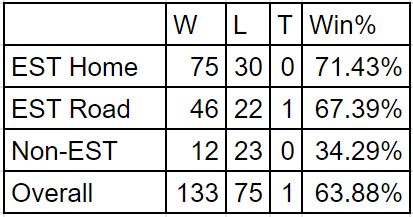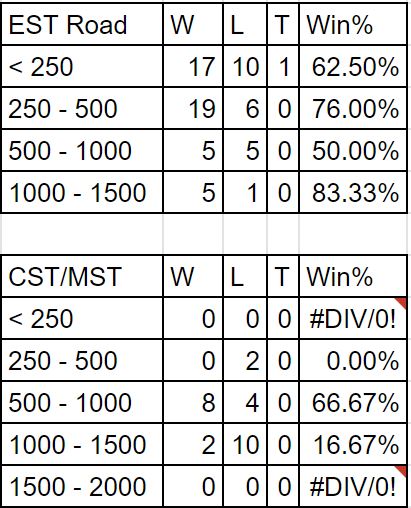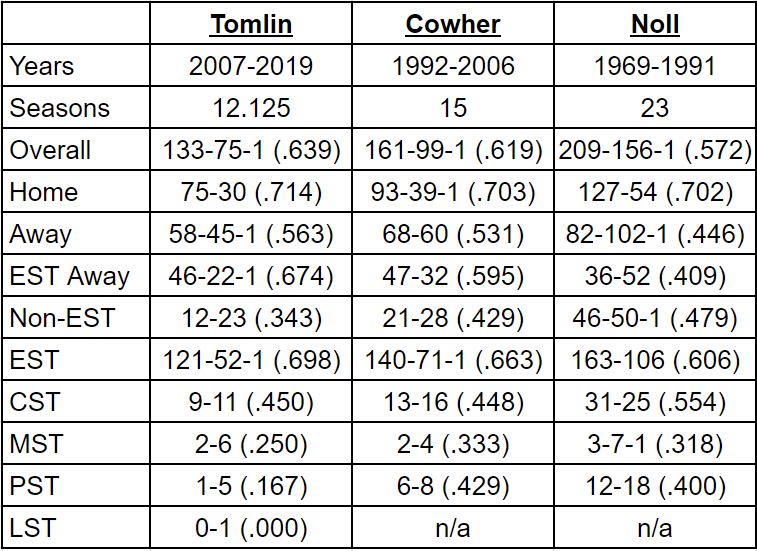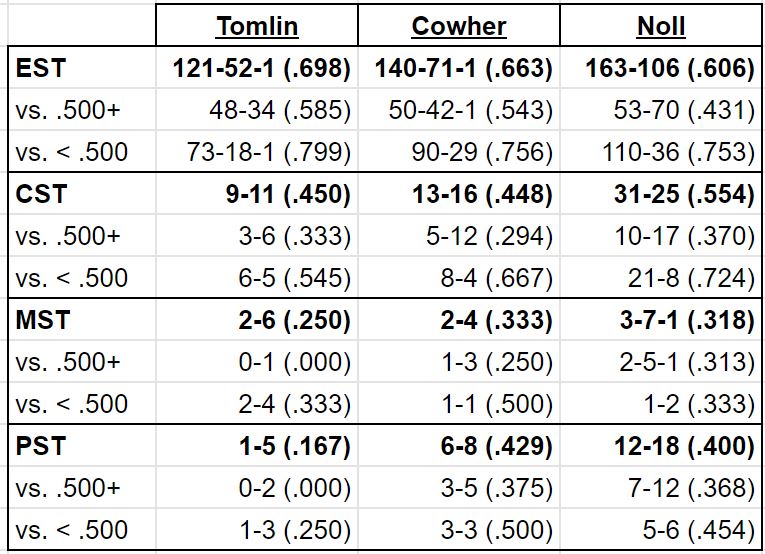The Steelers 2019 season could not have gotten off to a worse start with an 0-2 record and Ben Roethlisberger going down for the year. To salvage the season in Week 3, they have to travel to the West Coast where they have been historically terrible under Mike Tomlin. For those who have been long-time readers of my blogs and twitter, you know one of my favorite (weird) stats to harp on is the Steelers bizarre splits based on time zones. This is Mike Tomlin’s 13th season as head coach and he has inexplicably bad splits between his record in Eastern Standard Time and outside of Eastern Standard Time (that were not shared by his predecessors).
By Time Zone
During Mike Tomlin’s tenure the Steelers have been the second best team in the league with a 133-75-1 overall record (.639 winning percentage). Only New England (170-50, .773) has been better during that span. Hidden in that, however, is just how bad the Steelers are when they have to travel outside of their time zone. For reference, I have included all regular season and playoff games in this analysis, so this is a reflection of the Steelers true overall record, playoffs included.
Under Tomlin, the Steelers are 121-52-1 (.698) in all games played in the Eastern Time Zone. Obviously, being that our home games are played in Eastern Time, this number is slightly inflated by our 75-30 (.714) home record, which is the fourth-best in the league (behind New England, Green Bay, and Baltimore). When the Steelers leave home within the Eastern Time Zone, they are 46-22-1 (including their Super Bowl XLIII win in Tampa, which was a neutral location). This .674 winning percentage is the best in the league in road/neutral EST games (ahead of New England’s .672).
Given that the Steelers win over two-thirds of their road/neutral EST games, it is utterly shocking that they have posted a mere 12-23 (.343) mark when they leave the Eastern Time Zone. The Steelers have not exactly faced a gauntlet of quarterbacks in their non-EST games either. They have lost games to teams led by Tim Tebow, Matt Hasselbeck, Tony Romo, Matt Cassel, Terrelle Pryor, Mike Glennon, and Case Keenum.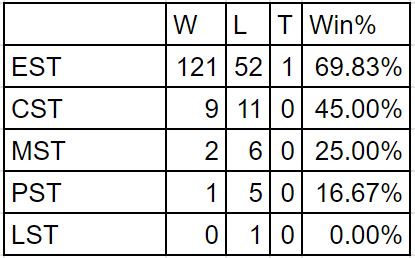
By Distance
All of the Steelers games in Pacific Time and London time zones fell into the “2000+” category, and they were 1-6 in those contests. The other games over 2000 miles away were in Arizona, where Mike Tomlin’s teams are 1-1. In order to get a better comparison between time zones and mileage, I split out the Steelers results in both Eastern time and Central/Mountain time by distance from home.
Based on these two charts, I feel comfortable saying that distance does not play a major role in the Steelers road splits. The biggest indicator is the team’s performance in games 1000-1500 miles away. When the Steelers have traveled over 1000 miles but stayed within the Eastern Time Zone, they are 5-1 – winning 3 times in Tampa (including the Super Bowl) and going 2-1 in Miami. However, when the Steelers traveled in the same distance range (1000-1500 miles) and changed time zones, their performance dropped off significantly. Their losses outside of EST in this travel range include 5 in Denver (two of those in the playoffs), 2 in Dallas (one in the Super Bowl), 1 in Houston and 2 in New Orleans. Their wins came in 2009 in Denver and in Houston. Given these numbers, I can not confidently say that distance traveled is the determining factor in the Steelers poor road splits.
This brings us back to time zones. Since the Steelers have won 40% of their games in Central and Mountain time, one would think that their performance would drop off even in Eastern Time the farther they traveled from home. As we have seen, this is simply not true as the Steelers do not have a losing record in any distance split in EST. In fact, all 5 of the Steelers losses in the 500-1000-mile distance in the Eastern Time Zone came in New England. The Steelers are 4-0 in that range against all other teams. Therefore, the disparity in record can be drawn purely along the time zone lines and not by actual distance.
In 2017 the Steelers went 2-1 in trips outside the Eastern Time Zone. After losing to Chicago in Week 3, they bounced back to score victories in Kansas City and Houston. Last year they were 0-3 with losses in Denver, Oakland, and New Orleans. This year, the team once again makes 3 more trips where they have to adjust their watches. The Steelers have only had a winning record outside of EST twice in Mike Tomlin’s tenure. The first came in 2016 when their only trip outside the time zone was a playoff win in Kansas City. The second was in 2017.
Postseason Woes Outside of EST
Before that 2016 victory in Kansas City, the Steelers had lost their last 3 playoff games outside of Eastern Time and were just 1-6 in playoff games outside the Eastern Time Zone since Bill Cowher took over as head coach in 1992. Before that win, their lone playoff win outside of EST came in the 2005 AFC Championship Game in Denver. Both of their Super Bowl losses came outside of Eastern Time with the loss to Dallas in Arizona and the loss to Green Bay in Dallas. Mike Tomlin is 2-1 in road/neutral playoff games in Eastern Time with wins at Cincinnati and over Arizona in the Super Bowl in Tampa. The only loss was in the 2016 AFC Championship in New England. Tomlin is 5-3 in home playoff games bringing his overall record to 7-4 in postseason games in Eastern Time and 1-3 in playoff games outside of EST.
Comparing With Other Coaches
@thesteelersnat To quote Chuck Noll, “Losing has nothing to do with geography.”
— Bob Labriola (@BobLabriola) July 17, 2014
As I mentioned at the outset, I have been harping on this weird statistic for a few years. After Steelers beat writer Bob Labriola brought up the infamous Chuck Noll quote, I took a look at the Steelers road splits under Bill Cowher and Chuck Noll to see if this was a trend that had been long-standing with the organization or a recent development under Mike Tomlin.
Under Cowher, there was a dropoff when the Steelers left the Eastern Time Zone, but it was not nearly as pronounced as Tomlin. Under Noll, the Steelers had a losing record overall on the road and were actually better outside the Eastern Time Zone. This gives some credence to Labriola’s Nollism. For Chuck Noll, this was true. Losing had nothing to do with geography because while his teams were excellent in Three Rivers Stadium, they lost a lot of games on the road. There was only a slight disparity between EST and non-EST road games for Noll’s Steelers. Overall, Tomlin’s greatest strength has been his ability to defend Heinz Field. In fact, Tomlin has the best home winning percentage of all three coaches. Tomlin’s biggest shortcomings in comparison to Cowher and Noll have been in the Mountain and Pacific Time Zones.
One of the criticisms of Mike Tomlin has been that his team “plays down” to the level of its opponents. Critics will commonly cite Tomlin’s losses against teams with losing records. While it is true that Tomlin has had his struggles against teams with losing records, particularly outside the Eastern Time Zone, his splits against those teams are not distinctly different than either of his predecessors. On the whole, Tomlin is 82-31-1 (.724) against teams that finished the season below .500. That .724 winning percentage is 5th best in the league during his 13 years as coach. Against that same cohort of losing teams, Cowher was 102-39 (.723) and Noll was 137-52 (.725). In total, Tomlin’s record against losing teams is essentially the same as Cowher’s and Noll’s records.
Tomlin’s teams have struggled outside the Eastern Time Zone, but they have been consistently better against below-.500 teams than they are against teams with winning records. Mike Tomlin has yet to beat a team that finished with a winning record in either the Mountain or Pacific Time zones.
Conclusion
On the whole, all three coaches have been successful. Tomlin’s .639 overall winning percentage is second-best in the league from 2007 through two weeks of 2019. Cowher’s .619 winning percentage was the best in the league from 1992-2006 and Noll’s .572 winning percentage was 8th-best in the league from 1969-1991. Overall, the Steelers’ 503-330-3 record (and .603 winning percentage) is the best in the league since 1969. The Steelers 503 wins in that time is 11 more than the next-closest team (Dallas). Of course, we can’t forget those 6 Super Bowl titles either. But if they’re going to stay on the road to the playoffs in hopes of winning a 7th this season, they will need to reverse Mike Tomlin’s troubling trend of dropping games outside of the Eastern Time Zone, starting with this week in Oakland.


